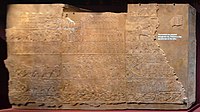Tammaritu I
| Tammaritu I | |
|---|---|
| |
| Father | Urtak |

Tammaritu I, son of Urtak, was briefly (from 653-652 BCE)[1] a ruler in the ancient kingdom of Elam, ruling after the beheading of his predecessor Teumman in 653. He ruled part of Elam while his brother, Ummanigash (son of Urtak), ruled another.[2][3]
Urtak, the father of Ummanigash and Tammaritu, had ruled Elam from 675 to 664, at which point he died and was succeeded by Teumman. When Teumman rose to power, Urtak's sons Ummanigash, Ummanappa, and Tammaritu escaped to Assyria in fear of Teumman,[4] and lived under Assyrian protection at Nineveh.[5] Based on his position in an Assyrian lists, Tammaritu was likely a younger son of Urtak.[6] The Assyrian Ashurbanipal, at the Battle of Ulai, killed Teumman, opening the way for the rule of Tammaritu and Ummanigash.
After the death of Teumman, the Assyrian king placed Ummanigash as "king" over the Elamite city of Madaktu, and his brother Tammaritu as "king" of Hidalu.
-
Ummanigash and Tammaritu acclaimed as rulers of Elam after theBattle of Tulliz.[8]
-
The relief in the British Museum
-
Detail
See also
- List of rulers of Elam
References
- ^ ISBN 978-1-57607-965-2.
- ISBN 978-0-275-96890-8.
- ISBN 978-0-521-22717-9.
- ^ D. T. Potts. (1999). The Archaeology of Elam: Formation and Transformation of an Ancient Iranian State. pp.277-8.
- ISBN 978-1-119-45907-1.
- ^ a b c d e D. T. Potts. (1999). The Archaeology of Elam: Formation and Transformation of an Ancient Iranian State. p. 280.
- ISBN 978-0-521-22717-9.
- ^ "Wall panel; relief British Museum". The British Museum.
- ^ Maspero, G. (Gaston); Sayce, A. H. (Archibald Henry); McClure, M. L. (1903). History of Egypt, Chaldea, Syria, Babylonia and Assyria. London : Grolier Society.
- ^ Maspero, G. (Gaston); Sayce, A. H. (Archibald Henry); McClure, M. L. (1903). History of Egypt, Chaldea, Syria, Babylonia and Assyria. London : Grolier Society. p. 427.

![Ummanigash and Tammaritu acclaimed as rulers of Elam after the Battle of Tulliz.[8]](http://upload.wikimedia.org/wikipedia/commons/thumb/7/79/Khumban-Igash_acclaimed_as_King_after_the_Battle_of_Tulliz.jpg/200px-Khumban-Igash_acclaimed_as_King_after_the_Battle_of_Tulliz.jpg)


![Tongue removal and live flaying of Elamite chiefs after the Battle of Ulai, 653 BCE.[9][10]](http://upload.wikimedia.org/wikipedia/commons/thumb/6/6d/Exhibition_I_am_Ashurbanipal_king_of_the_world%2C_king_of_Assyria%2C_British_Museum_%2844156996760%29.jpg/200px-Exhibition_I_am_Ashurbanipal_king_of_the_world%2C_king_of_Assyria%2C_British_Museum_%2844156996760%29.jpg)